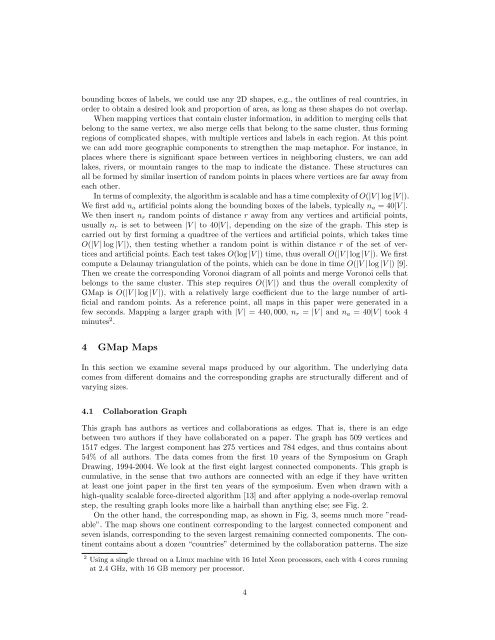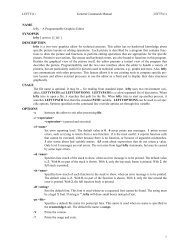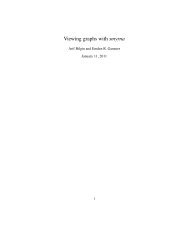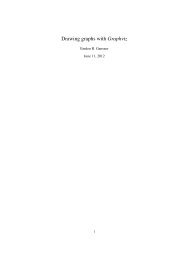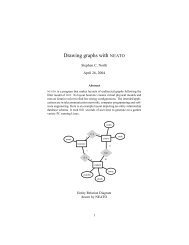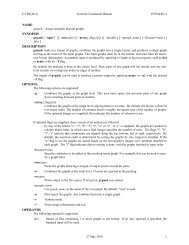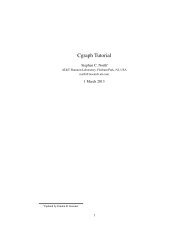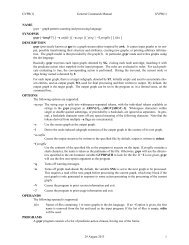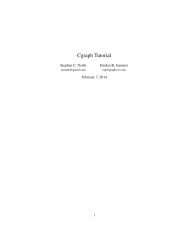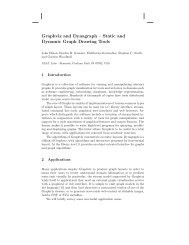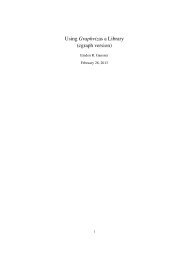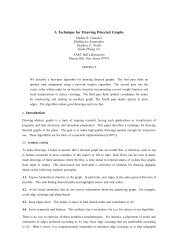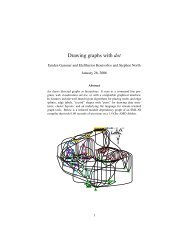Visualizing graphs and clusters as maps - Graphviz
Visualizing graphs and clusters as maps - Graphviz
Visualizing graphs and clusters as maps - Graphviz
Create successful ePaper yourself
Turn your PDF publications into a flip-book with our unique Google optimized e-Paper software.
ounding boxes of labels, we could use any 2D shapes, e.g., the outlines of real countries, in<br />
order to obtain a desired look <strong>and</strong> proportion of area, <strong>as</strong> long <strong>as</strong> these shapes do not overlap.<br />
When mapping vertices that contain cluster information, in addition to merging cells that<br />
belong to the same vertex, we also merge cells that belong to the same cluster, thus forming<br />
regions of complicated shapes, with multiple vertices <strong>and</strong> labels in each region. At this point<br />
we can add more geographic components to strengthen the map metaphor. For instance, in<br />
places where there is significant space between vertices in neighboring <strong>clusters</strong>, we can add<br />
lakes, rivers, or mountain ranges to the map to indicate the distance. These structures can<br />
all be formed by similar insertion of r<strong>and</strong>om points in places where vertices are far away from<br />
each other.<br />
In terms of complexity, the algorithm is scalable <strong>and</strong> h<strong>as</strong> a time complexity of O(|V | log |V |).<br />
We first add n a artificial points along the bounding boxes of the labels, typically n a = 40|V |.<br />
We then insert n r r<strong>and</strong>om points of distance r away from any vertices <strong>and</strong> artificial points,<br />
usually n r is set to between |V | to 40|V |, depending on the size of the graph. This step is<br />
carried out by first forming a quadtree of the vertices <strong>and</strong> artificial points, which takes time<br />
O(|V | log |V |), then testing whether a r<strong>and</strong>om point is within distance r of the set of vertices<br />
<strong>and</strong> artificial points. Each test takes O(log |V |) time, thus overall O(|V | log |V |). We first<br />
compute a Delaunay triangulation of the points, which can be done in time O(|V | log |V |) [9].<br />
Then we create the corresponding Voronoi diagram of all points <strong>and</strong> merge Voronoi cells that<br />
belongs to the same cluster. This step requires O(|V |) <strong>and</strong> thus the overall complexity of<br />
GMap is O(|V | log |V |), with a relatively large coefficient due to the large number of artificial<br />
<strong>and</strong> r<strong>and</strong>om points. As a reference point, all <strong>maps</strong> in this paper were generated in a<br />
few seconds. Mapping a larger graph with |V | = 440, 000, n r = |V | <strong>and</strong> n a = 40|V | took 4<br />
minutes 2 .<br />
4 GMap Maps<br />
In this section we examine several <strong>maps</strong> produced by our algorithm. The underlying data<br />
comes from different domains <strong>and</strong> the corresponding <strong>graphs</strong> are structurally different <strong>and</strong> of<br />
varying sizes.<br />
4.1 Collaboration Graph<br />
This graph h<strong>as</strong> authors <strong>as</strong> vertices <strong>and</strong> collaborations <strong>as</strong> edges. That is, there is an edge<br />
between two authors if they have collaborated on a paper. The graph h<strong>as</strong> 509 vertices <strong>and</strong><br />
1517 edges. The largest component h<strong>as</strong> 275 vertices <strong>and</strong> 784 edges, <strong>and</strong> thus contains about<br />
54% of all authors. The data comes from the first 10 years of the Symposium on Graph<br />
Drawing, 1994-2004. We look at the first eight largest connected components. This graph is<br />
cumulative, in the sense that two authors are connected with an edge if they have written<br />
at le<strong>as</strong>t one joint paper in the first ten years of the symposium. Even when drawn with a<br />
high-quality scalable force-directed algorithm [13] <strong>and</strong> after applying a node-overlap removal<br />
step, the resulting graph looks more like a hairball than anything else; see Fig. 2.<br />
On the other h<strong>and</strong>, the corresponding map, <strong>as</strong> shown in Fig. 3, seems much more ”readable”.<br />
The map shows one continent corresponding to the largest connected component <strong>and</strong><br />
seven isl<strong>and</strong>s, corresponding to the seven largest remaining connected components. The continent<br />
contains about a dozen “countries” determined by the collaboration patterns. The size<br />
2 Using a single thread on a Linux machine with 16 Intel Xeon processors, each with 4 cores running<br />
at 2.4 GHz, with 16 GB memory per processor.<br />
4


